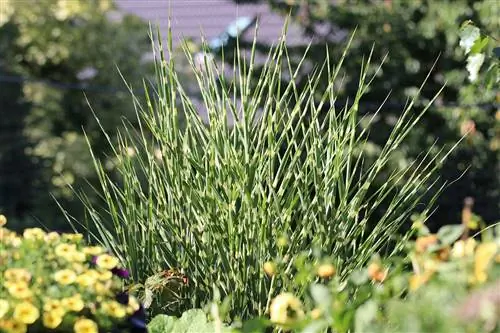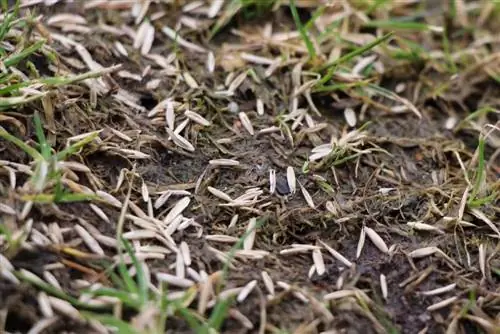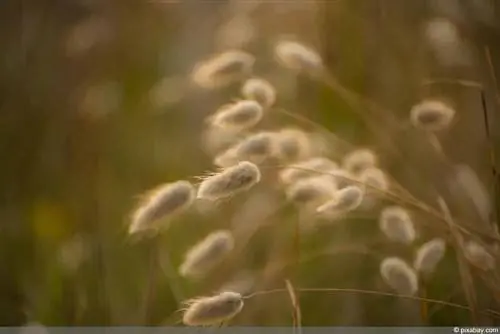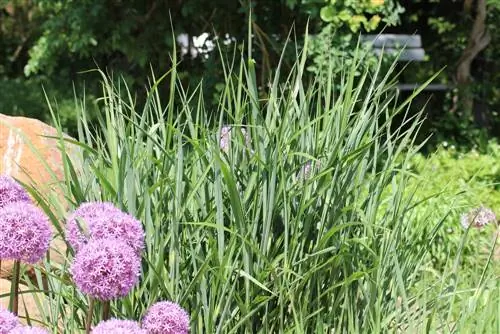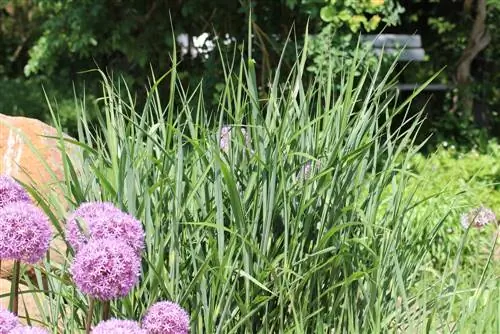- Author admin [email protected].
- Public 2023-12-17 03:39.
- Last modified 2025-01-24 12:45.
Zebra grass is a wonderful privacy screen that is extremely easy to care for and can even be decorative in winter. The following guide shows what to pay attention to.
Location
Zebra grass has a particularly decorative effect thanks to its striped leaves. Since it can reach a height of up to two meters, it serves, among other things, as a privacy screen, shade for other plants and a vestibule.
Miscanthus sinensis can also be cultivated outdoors or in a pot on the balcony or terrace. In any case, you must choose the location carefully. The following requirements must be met:
- avoid very exposed areas
- sunny or at least partly sunny
- warm
Note:
Shady locations are also possible. However, the typical zebra stripes on the stalks are not so clearly visible.
Substrate
The soil for Miscanthus sinensis must meet various criteria. These are the points:
- permeable
- humos
- easy
- loamy
- moderately nutritious
- sandy
Bamboo soil or grass soil, for example, is ideal. This is already tailored to the needs of the plants and does not require any further mixing. It should therefore be used especially in pot culture. However, an alternative is a mixture of garden soil, sand, mature compost and coconut fiber.
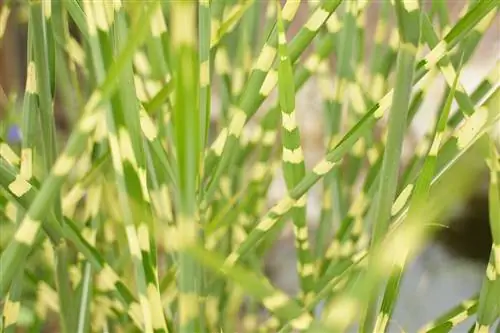
Pouring
The plant needs plenty of water. Especially in summer or when growing in containers. In these cases it may even be necessary to water several times a day. It is ideal to use soft, low-lime water and to plant the plant in the immediate vicinity of a body of water. Suitable sources of soft water include:
- stale tap water
- Aquarium water
- filtered tap water
- Pond water
- soft tap water
When it comes to pond water and aquarium water, make sure that it is untreated. You can find out whether your own tap water is low in lime from the responsible water authority or determine it through a test. Many offices also offer this information online.
Note:
Avoid waterlogging as a matter of urgency. Even though zebra grass needs a lot of water, it is extremely susceptible to rot.
Fertilize
Zebra grass requires sufficient nutrients due to its rapid growth and enormous height. Fertilization should therefore be carried out regularly during the growing season. From March to the end of August or beginning of September, the following means can be used:
- Grass Fertilizer
- Humus
- Compost
- Plant manure
Depending on the particular fertilizer, the frequency and quantity must also be selected. Special grass fertilizer has the advantage that the amount of nutrients it contains is known precisely. This makes it easy to avoid incorrect dosages. Regardless of which means you choose, there are a few points you must adhere to. These are:
- sufficient watering after nutrient addition
- Stopping fertilization in late summer
- add liquid fertilizer to the irrigation water
- Work dry fertilizers well into the substrate
Comprehensive watering is important so that the nutrients can be distributed evenly and do not cause chemical burns on the roots. These arise when the minerals are present in too high a concentration at certain points.
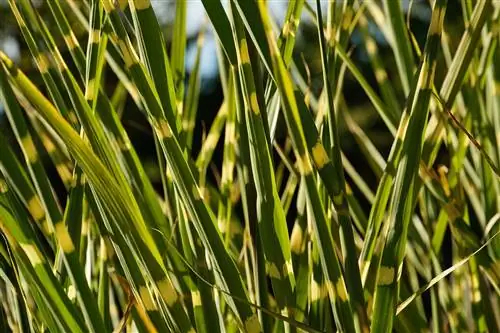
Blend
The trimming or pruning should be done once a year. The best time is immediately after overwintering and before the plant sprouts again.
This action only requires a few steps. These are:
Choose clean cutting tools
Even if the parts of the plant are already dry, cut surfaces can serve as entry points for pathogens or parasites. The blades of the cutting tool should therefore be cleaned before cutting.
Sharp Blades
Sharp and strong secateurs are ideal for this measure. If the blades are dull, the grass is more likely to be crushed and torn than cut. This can cause damage to the plant.
Radically shorten
When cutting back, the stalks should be shortened close to the ground. This means the new shoots have more space and receive more light. This promotes he althy and strong growth.
Tip:
It helps to bend the stalks outwards and downwards before cutting. If there are already young shoots, they can be recognized better and are not accidentally shortened.
Bucket Culture
Caring for Miscanthus sinensis in pot culture requires a little more effort in terms of care. The reason for this is that the plant has less substrate available. This results in smaller amounts of both nutrients and water reserves. In addition, waterlogging can occur more quickly.
So pay attention to the following points:
- sufficient watering, up to twice a day in summer
- Drainage in the planter for water drainage
- more frequent fertilization every two weeks, depending on the respective product
- regular repotting every two to three years
- Overwintering in protected areas or with root protection
The care must therefore be carried out more closely. Frequent watering is essential, especially in summer, when temperatures are very high and the soil dries out more quickly. The larger the bucket and the more soil the plant has available, the more scope there is and the less effort is required.
Another advantage is that a planter with a large volume offers more stability. There is also greater protection against complete freezing.
Wintering
The striped grass is hardy outdoors down to -20 degrees Celsius. However, this only applies if it was planted in spring and has grown well. Otherwise, additional protection should be applied around the plant. This can be, for example, straw, brushwood or mulch. Garden fleece is also a possible alternative. When growing in containers, it is recommended to wrap the planter with protective fleece and insulate it from below. A sheet made of Styrofoam or a Euro pallet, which avoids direct contact with the surface, is suitable for this.
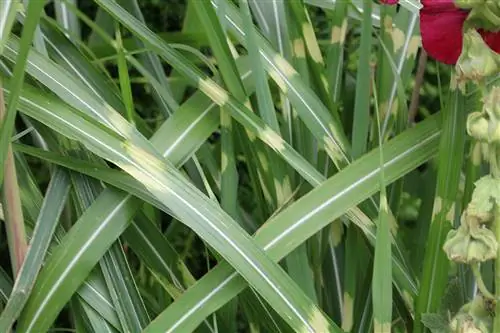
In addition, in both cases you must respect the following criteria:
- spend in a protected location
- Avoid drying out
- Stop fertilization in summer
- water only on frost-free days
Diseases & Pests
The striped grass with its impressive height is inherently robust and not very vulnerable. Diseases do not occur as long as there is no waterlogging or drying out. Pests such as lice are also extremely rare. Even if they attack the plant, they usually cause little damage and disappear again without any action. Home remedies such as soapy water, diluted milk but also yellow tablets or natural predators can be used if necessary.
Care errors
Maintenance errors, however, can certainly occur. The most common problems are:
Missing waste
If pruning is not done, the dried leaves can gradually rot in spring. The germs responsible for this may also spread to the young shoots.
Waterlogging
Although the plants need to be watered regularly and abundantly, waterlogging should be avoided. In planters, this can be prevented with a drainage layer. Good drainage must also be ensured near bodies of water. To do this, when planting the plants, a layer of gravel can be added to separate the roots from the wet soil.
Compacted substrate
The roots of zebra grass require loose and well-drained soil. This goal can be achieved with sand and coconut fibers.
Too few nutrients
A lack of fertilizer, especially in the pot, quickly leads to delayed growth and increased susceptibility to diseases and pests.

